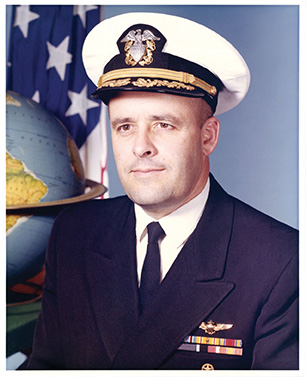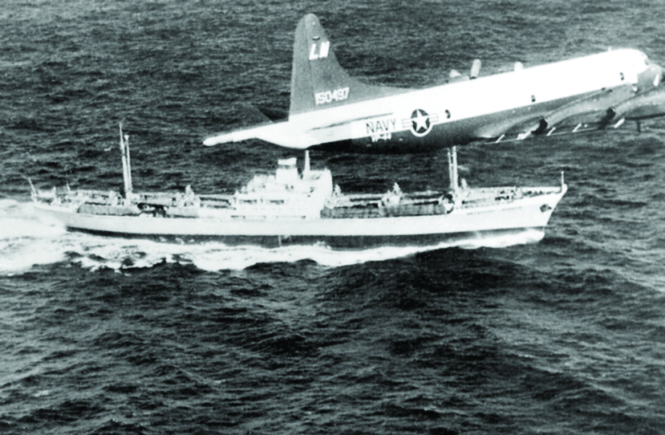U.S. Navy captain Andrew “Andy” Serrell certainly loved to fly — and he left an indelible mark on history and on his students
Story by Ian Post | Photography courtesy Nabb Research Center, Salisbury University
While we often say that heroes walk among us, it’s rarely said that they fly with — and above — us. In West Ocean City, flight instructor, aerial photographer and former U.S. Navy captain Andrew “Andy” Serrell carried his history-making legacy as he maintained his dedication to the sky into his 90s.
Born in Dobbs Ferry, NY, in 1923, Serrell earned his pilot’s license at the age of 17. In 1942, he enlisted as an aviation cadet in the U.S. Naval Reserve and was called into active duty one year later. Serrell began to discover his passion for aerial photography in 1944, when he was assigned to a photographic squadron. However, he was soon moved to Patrol Bombing Squadron 121 in the Pacific Theater, where he served for the rest of World War II.

Andrew “Andy” Serrell
During his service in the war, Serrell flew out of island bases in the Western Pacific and participated in raids against the Marshall and Wake Islands. In 1945, as the war was nearing its end, Serrell flew during the operations on the Japanese island of Iwo Jima. His service in the Pacific Theater earned him an Air Medal with two gold stars and the Asia Pacific Theater Ribbon with one battle star.
After the war, Serrell remained in the Navy and moved from base to base in places like New York, California, Alabama and Virginia. His family — wife Beverly Francis and four children — faithfully followed as Andy continued his service in the skies.
DURING THE CUBAN MISSILE CRISIS, SERRELL’S SQUADRON FLEW SURVEILLANCE AIRCRAFT DURING RECONNAISSANCE MISSIONS OVER PRESIDENT JOHN F. KENNEDY’S QUARANTINE ZONE — ESTABLISHED AS AN ARC 500 MILES FROM CAPE MAYSI, CUBA. IN NOVEMBER 1962, AFTER THE USS BARRY WAS ORDERED TO INVESTIGATE THE MISSILE-CARRYING SOVIET-BOUND SHIP METALLURG ANOSOV, SERRELL FLEW ABOVE THE SHIP IN THIS INTERNATIONALLY KNOWN IMAGE AFTER THE SOVIET CAPTAIN REFUSED TO REVEAL THE SHIP’S CARGO.
At the height of the Cold War, Serrell honed his “eye in the sky” as the commanding officer of Patrol Squadron 44 (VP-44), based in Patuxent River, MD. After President John F. Kennedy negotiated with the Soviet Union for the removal of ballistic missiles from Cuba, Serrell’s squadron flew the P-3 Orion anti-submarine surveillance aircraft during reconnaissance. In fact, a front-page November 1962 photograph showed Serrell piloting an LM-4 over the missile-carrying Soviet-bound ship Metallurg Anosov. Following his time in VP-44, Serrell was promoted to captain and assigned to roles within the Pentagon, including chief briefing officer to the chief of naval operations.
When Serrell retired from the Navy, in 1974, he and his family moved to Ocean Pines, where Serrell started Ocean City Aircraft, Inc. for flight instruction and Aero Graphics for aerial photography. With his “eye in the sky,” Serrell captured thousands of aerial images of both familiar and remote places in Sussex and Worcester counties; his thorough location identification and cataloging now provide researchers with precision aerial images dating to the 1980s. Back on the ground, he became well-known within the aviation community for mentoring countless pilots in his flight school, advocating for the West Ocean City Airport and leading organizations like the Ocean City Aviation Association.

CLEARED FOR DEPARTURE Serrell, shown here in 1941, shortly after earning his pilot’s license, enlisted in the U.S. Naval Reserve as an aviation cadet one year later.
Serrell continued to fly into his 90s and never stopped learning throughout his career, earning degrees from the University of Maryland, George Washington University and the Industrial College of the Armed Forces. After he passed away, in January 2018, Andy and Beverly were interred at Arlington National Cemetery. Serrell’s story lives on through the Serrell Family Collection at the Nabb Research Center at Salisbury University, which includes Andy’s flight logs, aviation instruments, aerial photographs, artifacts and more.
Editor’s note: Ian Post is the local history archivist (formerly university archivist and special collections librarian) at the Nabb Research Center at Salisbury University.

